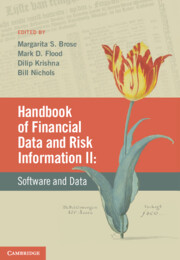Book contents
- Frontmatter
- Contents
- List of contributors
- Preface
- VOLUME II: SOFTWARE AND DATA
- PART IV DATA OPERATIONS IN FINANCIAL INSTITUTIONS
- PART V DATA MANAGEMENT TECHNOLOGIES
- PART VI IMPLEMENTATION OF DATA AND ANALYTICS PROGRAMS
- 25 Project implementation
- 26 Operations management
- 27 Data governance and data stewardship
- Index – Volume II
- References
27 - Data governance and data stewardship
from PART VI - IMPLEMENTATION OF DATA AND ANALYTICS PROGRAMS
- Frontmatter
- Contents
- List of contributors
- Preface
- VOLUME II: SOFTWARE AND DATA
- PART IV DATA OPERATIONS IN FINANCIAL INSTITUTIONS
- PART V DATA MANAGEMENT TECHNOLOGIES
- PART VI IMPLEMENTATION OF DATA AND ANALYTICS PROGRAMS
- 25 Project implementation
- 26 Operations management
- 27 Data governance and data stewardship
- Index – Volume II
- References
Summary
What is data governance?
Background
Data governance, the exercise of decision-making and authority for data related matters, has developed over the past years in response to organizations recognizing the need to have better control over continuously growing volumes of enterprise data. The term data governance has a myriad of definitions and this chapter will present a sample of those views and attempt to rationalize definitions into an actionable understanding.
Data governance broadly refers to the statues, regulations, policies, standards, guidelines, business rules, organizational bodies, decision rights (deciding how to decide), accountabilities and enforcement methods for people and information systems as data related processes are performed across the enterprise. Practices and frameworks have been developed to include multiple enterprise data performance activities including data quality, data protection, data visibility and security, data archival, data definitions, content management, data warehousing, metadata management, and master data management.
According to the Data Governance Institute (Definitions), a well-defined and complete data governance solution is a system of decision rights and accountabilities for information-related processes, executed according to agreed-upon models which describe who can take what actions with what information, and when, under what circumstances, and using what methods. There are other valuable views and definitions of data governance.
- Type
- Chapter
- Information
- Handbook of Financial Data and Risk Information IISoftware and Data, pp. 464 - 520Publisher: Cambridge University PressPrint publication year: 2014



